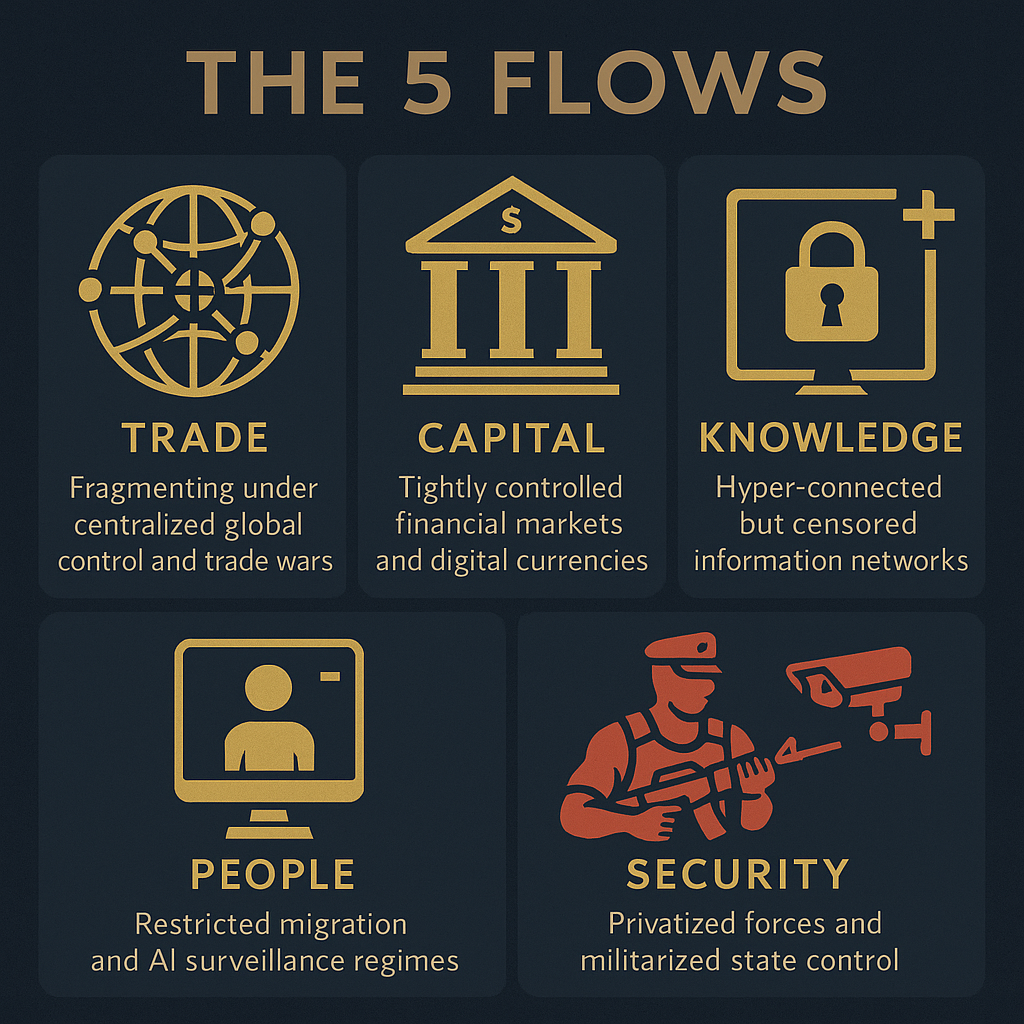Introduction: Barnett’s Vision
In his address, Thomas Barnett outlines a dynamic, global model based on five key “flows”: people, energy, money, security, and ideas. His thinking reimagined globalization not as a smooth, centralized process, but as a messy, decentralized migration of needs, ambitions, and technologies from regions of scarcity (the “Gap”) to regions of stability and wealth (the “Core”).
The United States, in Barnett’s view, was tasked not with controlling these flows rigidly, but with managing and securing them, ensuring that the transition between old powers and rising regions happened peacefully — protecting “globalization itself” as the highest strategic interest.
Barnett warned that we were entering a “Trans-Pacific Era” (shifting from the historic “Trans-Atlantic Era”), and forecasted demographic, economic, and security transformations, with Asia — particularly China — moving to the center of global gravity.
His warning was clear:
“Globalization is a force of nature, moving humanity forward through instability. If managed poorly, it erupts into chaos.”
Key Themes Barnett Raised (Early 2010s)
- Aging of developed societies (US, Europe, Japan) would stress economies and create labor shortages.
- Global migration flows (especially youth from “the Gap” to “the Core”) would trigger cultural tension and new hybrid societies.
- Arab world revolutions (Arab Spring) were demographically inevitable due to a massive youth bulge without jobs.
- Rise of China and Asia would shift economic power eastward.
- Global instability would increasingly be the product of decentralized, “super-empowered individuals,” not just states.
- America’s role was to secure and connect the global system, not dominate it in an imperial sense.
- Nuclear proliferation in the Middle East would ironically stabilize the region, similarly to how nuclear weapons stabilized Cold War Europe.
How These Predictions Have Developed Since Then
1. Demographic Shifts: Aging, Fertility Collapse, and Migration
Barnett was absolutely right:
- Western societies (Europe, Japan, the US) face rapid aging, low fertility, and shrinking labor pools.
- Immigration is essential but politically controversial, fueling nationalism and populism.
- China’s own aging crisis (thanks to the one-child policy) emerged faster than expected, putting its long-term economic growth at risk.
- Africa remains the youngest and fastest-growing population center, setting the stage for it to become the new “Gap” to “Core” migrant wave over the 21st century.
Today’s Reality:
In Europe and North America, debates over immigration, nationalism, and multiculturalism dominate political life. Aging societies are desperate for youth but resist the social transformations that immigration brings.
2. Arab Spring and Its Aftermath
Barnett saw the Arab Spring as demographically inevitable: millions of young men without jobs or future prospects. He emphasized that globalization itself, by raising aspirations without delivering opportunities, was the “hidden driver.”
What Happened:
- Arab Spring revolutions overthrew governments (Tunisia, Egypt, Libya) but largely collapsed into civil wars (Syria, Yemen, Libya).
- Authoritarianism returned stronger (e.g., Egypt under Sisi).
- Radical groups like ISIS exploited the chaos.
- The hopes of democratization have largely failed, with only Tunisia seeing partial success.
Today’s Reality:
The Middle East remains unstable. Instead of democratization, we have stronger security states, foreign interventions (Russia, Turkey, Iran), and mass migrations into Europe.
3. The Rise of China and New Multipolarity
Barnett predicted a shift to multipolarity — with China leading the “new core” along with India, Brazil, and others.
What Happened:
- China’s economy exploded, surpassing the EU’s in size.
- China became the “world’s factory” and launched massive global infrastructure projects (Belt and Road Initiative).
- The US-China relationship shifted from “engagement” to open rivalry — economically, militarily, and technologically.
- New mini-alliances formed: BRICS expansion, ASEAN strengthening, India asserting itself.
Today’s Reality:
Globalization has fragmented into competing blocs — the US-led West, the China-Russia bloc, and the emerging “Global South” resisting both.
4. Super-Empowered Individuals and the Weaponization of Information
Barnett’s “super-empowered individual” concept exploded with the rise of:
- Hackers (Anonymous, Wikileaks, ransomware gangs)
- Influencers and online movements (Occupy Wall Street, QAnon, Extinction Rebellion)
- Citizen-driven revolutions fueled by smartphones and social media (e.g., Hong Kong protests, Black Lives Matter, Canadian trucker protests).
Today’s Reality:
Globalization’s new “flow” is information, weaponized and spread faster than any military force. Social media creates new ideological battlespaces daily, often destabilizing governments and societies.
5. Security Through Connectivity — and the New Fragmentation
Barnett argued America’s role was to secure globalization’s network, not dominate nations through imperial conquest. “Connectivity is security,” he said.
What Happened:
- The US war fatigue from Iraq and Afghanistan led to a retrenchment (Obama “pivot to Asia”, Trump “America First”, Biden’s messy withdrawal from Afghanistan).
- “Connectivity” (economic globalization) is now fraying as supply chains decouple, data privacy walls go up, and protectionism rises.
- New Cold War dynamics have emerged — US vs. China, with Russia’s invasion of Ukraine marking a return to “hard” security conflicts.
Today’s Reality:
Globalization survives — but in a much more regionalized and conflicted form.
Current Global Map (Barnett’s Model Evolved)
| Flow | 2010s Prediction | 2020s Reality |
|---|---|---|
| People | Migration from Gap to Core | Yes, but massive backlash (nationalism, immigration control) |
| Energy | Shift from Middle East to renewables | In process, but Middle East oil remains dominant |
| Money | Global financial integration | Fragmenting: sanctions, currency wars, de-dollarization efforts |
| Security | Core secures Gap | Failed: endless wars collapsed into regional instability |
| Ideas | Spread of globalization ideals | Now polarized between liberal democracy, authoritarianism, populism |
Conclusion: Barnett’s Vision in 2025
Thomas Barnett foresaw globalization’s explosive, destabilizing effects, and he mapped out the underlying drivers better than almost any public strategist of his time.
However, he may have underestimated:
- The speed of cultural backlash against migration and integration.
- The rise of populism and nationalism in the core (Trump, Brexit, etc.).
- The fragmentation of the Internet into “splinternets” (US, China, EU, Russia versions).
- The return of hard power geopolitics (Ukraine war, Taiwan tensions).
Ultimately, Barnett described globalization as an unstoppable, natural process, like water finding its level.
Today, we see that while the flow cannot be stopped, it can be redirected, diverted, and even weaponized.
In a world now facing de-globalization, population collapse, new technological empires, and fragmented alliances, Barnett’s core idea remains relevant:
The future isn’t about walls — it’s about who can manage flows wisely, humanely, and strategically.






